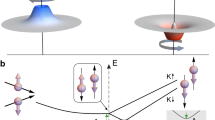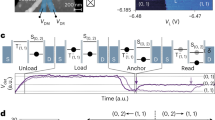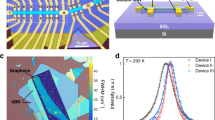Abstract
Coherent manipulation of the binary degrees of freedom is at the heart of modern quantum technologies. Graphene offers two binary degrees: the electron spin and the valley. Efficient spin control has been demonstrated in many solid-state systems, whereas exploitation of the valley has only recently been started, albeit without control at the single-electron level. Here, we show that van der Waals stacking of graphene onto hexagonal boron nitride offers a natural platform for valley control. We use a graphene quantum dot induced by the tip of a scanning tunnelling microscope and demonstrate valley splitting that is tunable from −5 to +10 meV (including valley inversion) by sub-10-nm displacements of the quantum dot position. This boosts the range of controlled valley splitting by about one order of magnitude. The tunable inversion of spin and valley states should enable coherent superposition of these degrees of freedom as a first step towards graphene-based qubits.
This is a preview of subscription content, access via your institution
Access options
Access Nature and 54 other Nature Portfolio journals
Get Nature+, our best-value online-access subscription
$29.99 / 30 days
cancel any time
Subscribe to this journal
Receive 12 print issues and online access
$259.00 per year
only $21.58 per issue
Buy this article
- Purchase on Springer Link
- Instant access to full article PDF
Prices may be subject to local taxes which are calculated during checkout




Similar content being viewed by others
References
Ladd, T. D. et al. Quantum computers. Nature 464, 45–53 (2010).
Pioro-Ladriere, M. et al. Electrically driven single-electron spin resonance in a slanting Zeeman field. Nat. Phys. 4, 776–779 (2008).
Wu, X. et al. Two-axis control of a singlet-triplet qubit with an integrated micromagnet. Proc. Natl Acad. Sci. USA 111, 11938–11942 (2014).
Abanin, D. A. et al. Giant nonlocality near the Dirac point in graphene. Science 332, 328–330 (2011).
Shimazaki, Y. et al. Generation and detection of pure valley current by electrically induced Berry curvature in bilayer graphene. Nat. Phys. 11, 1032–1036 (2015).
Sui, M. et al. Gate-tunable topological valley transport in bilayer graphene. Nat. Phys. 11, 1027–1031 (2015).
Ju, L. et al. Topological valley transport at bilayer graphene domain walls. Nature 520, 650–655 (2015).
Wallbank, J. R. et al. Tuning the valley and chiral quantum state of Dirac electrons in van der Waals heterostructures. Science 353, 575–579 (2016).
Rahman, R. et al. Engineered valley-orbit splittings in quantum-confined nanostructures in silicon. Phys. Rev. B 83, 195323 (2011).
Yang, C. H. et al Spin-valley lifetimes in a silicon quantum dot with tunable valley splitting. Nat. Commun. 4, 2069 (2013).
Gokmen, T. et al. Parallel magnetic-field tuning of valley splitting in AlAs two-dimensional electrons. Phys. Rev. B 78, 233306 (2008).
Kobayashi, T. et al. Resonant tunneling spectroscopy of valley eigenstates on a donor-quantum dot coupled system. Appl. Phys. Lett. 108, 152102 (2016).
Gamble, J. K. et al. Valley splitting of single-electron Si MOS quantum dots. Appl. Phys. Lett. 109, 253101 (2016).
Scarlino, P. et al. Dressed photon-orbital states in a quantum dot: Intervalley spin resonance. Phys. Rev. B 95, 165429 (2017).
Mi, X., Péterfalvi, C. G., Burkard, G. & Petta, J. High-resolution valley spectroscopy of Si quantum dots. Phys. Rev. Lett. 119, 176803 (2017).
Xiao, D., Yao, W. & Niu, Q. Valley-contrasting physics in graphene: Magnetic moment and topological transport. Phys. Rev. Lett. 99, 236809 (2007).
Pesin, D. & MacDonald, A. H. Spintronics and pseudospintronics in graphene and topological insulators. Nat. Mater. 11, 409–416 (2012).
Castro Neto, A. H., Guinea, F., Peres, N. M. R., Novoselov, K. S. & Geim, A. K. The electronic properties of graphene. Rev. Mod. Phys. 81, 109–162 (2009).
Geim, A. K. & Grigorieva, I. V. Van der Waals heterostructures. Nature 499, 419–425 (2013).
Woods, C. R. et al. Commensurate-incommensurate transition in graphene on hexagonal boron nitride. Nat. Phys. 10, 451–456 (2014).
Novoselov, K. S., Mishchenko, A., Carvalho, A. & Castro Neto, A. H. 2D materials and van der Waals heterostructures. Science 353, 461–470 (2016).
Freitag, N. M. et al. Electrostatically confined monolayer graphene quantum dots with orbital and valley splittings. Nano Lett. 16, 5798–5805 (2016).
Bischoff, D. et al. Localized charge carriers in graphene nanodevices. Appl. Phys. Rev. 2, 031301 (2015).
Allen, M. T., Martin, J. & Yacoby, A. Gate-defined quantum confinement in suspended bilayer graphene. Nat. Commun. 3, 934 (2012).
Goossens, A. M. et al. Gate-defined confinement in bilayer graphene-hexagonal boron nitride hybrid devices. Nano Lett. 12, 4656–4660 (2012).
Müller, A. et al. Bilayer graphene quantum dot defined by topgates. J. Appl. Phys. 115, 233710 (2014).
Mayorov, A. S. et al. Micrometer-scale ballistic transport in encapsulated graphene at room temperature. Nano Lett. 11, 2396–2399 (2011).
Kretinin, A. V. et al. Electronic properties of graphene encapsulated with different two-dimensional atomic crystals. Nano Lett. 14, 3270–3276 (2014).
Sachs, B., Wehling, T. O., Katsnelson, M. I. & Lichtenstein, A. I. Adhesion and electronic structure of graphene on hexagonal boron nitride substrates. Phys. Rev. B 84, 195414 (2011).
van Wijk, M. M., Schuring, A., Katsnelson, M. I. & Fasolino, A. Moiré patterns as a probe of interplanar interactions for graphene on h-BN. Phys. Rev. Lett. 113, 135504 (2014).
Chizhova, L. A., Libisch, F. & Burgdörfer, J. Graphene quantum dot on boron nitride: Dirac cone replica and Hofstadter butterfly. Phys. Rev. B 90, 165404 (2014).
San-Jose, P., Gutiérrez-Rubio, A., Sturla, M. & Guinea, F. Spontaneous strains and gap in graphene on boron nitride. Phys. Rev. B 90, 075428 (2014).
Slotman, G. J. et al. Effect of structural relaxation on the electronic structure of graphene on hexagonal boron nitride. Phys. Rev. Lett. 115, 186801 (2015).
Jung, J. et al. Moiré band model and band gaps of graphene on hexagonal boron nitride. Phys. Rev. B 96, 085442 (2017).
Ambrosetti, A., Ferri, N., DiStasio, R. A. Jr. & Tkatchenko, A. Wavelike charge density fluctuations and van der Waals interactions at the nanoscale. Science 351, 1171–1176 (2016).
Morgenstern, M. et al. Origin of Landau oscillations observed in scanning tunneling spectroscopy on n-InAs(110). Phys. Rev. B 62, 7257–7263 (2000).
Dombrowski, R., Steinebach, C., Wittneven, C., Morgenstern, M. & Wiesendanger, R. Tip-induced band bending by scanning tunneling spectroscopy of the states of the tip-induced quantum dot on inas(110). Phys. Rev. B 59, 8043–8048 (1999).
Xue, J. M. et al. Scanning tunnelling microscopy and spectroscopy of ultra-flat graphene on hexagonal boron nitride. Nat. Mater. 10, 282–285 (2011).
Decker, R. et al. Local electronic properties of graphene on a BN substrate via scanning tunneling microscopy. Nano Lett. 11, 2291–2295 (2011).
Mashoff, T. et al. Bistability and oscillatory motion of natural nanomembranes appearing within monolayer graphene on silicon dioxide. Nano Lett. 10, 461–465 (2010).
Georgi, A. et al. Tuning the pseudospin polarization of graphene by a pseudomagnetic field. Nano Lett. 17, 2240–2245 (2017).
Libisch, F., Rotter, S., Güttinger, J., Stampfer, C. & Burgdörfer, J. Transition to Landau levels in graphene quantum dots. Phys. Rev. B 81, 245411 (2010).
Haigh, S. J. et al. Cross-sectional imaging of individual layers and buried interfaces of graphene-based heterostructures and superlattices. Nat. Mater. 11, 764–767 (2012).
Wong, D. et al. Characterization and manipulation of individual defects in insulating hexagonal boron nitride using scanning tunnelling microscopy. Nat. Nanotech. 10, 949–953 (2015).
Morgenstern, M., Freitag, N., Nent, A., Nemes-Incze, P. & Liebmann, M. Graphene quantum dots probed by scanning tunneling microscopy. Ann. Phys. 529, 1700018 (2017).
Petta, J. et al. Coherent manipulation of coupled electron spins in semiconductor quantum dots. Science 309, 2180–2184 (2005).
Elzerman, J. M. et al. Single-shot read-out of an individual electron spin in a quantum dot. Nature 430, 431–435 (2004).
Trauzettel, B., Bulaev, D. V., Loss, D. & Burkard, G. Spin qubits in graphene quantum dots. Nat. Phys. 3, 192–196 (2007).
Wang, Z. et al. Origin and magnitude of ‘designer’ spin-orbit interaction in graphene on semiconducting transition metal dichalcogenides. Phys. Rev. X 6, 041020 (2016).
Jiang, Y. et al. Visualizing strain-induced pseudomagnetic fields in graphene through an hBN magnifying glass. Nano Lett. 17, 2839–2843 (2017).
Mashoff, T., Pratzer, M. & Morgenstern, M. A low-temperature high resolution scanning tunneling microscope with a three-dimensional magnetic vector field operating in ultrahigh vacuum. Rev. Sci. Instr. 80, 053702 (2009).
Voigtländer, B., Cherepanov, V., Elsaesser, C. & Linke, U. Metal bead crystals for easy heating by direct current. Rev. Sci. Instr. 79, 033911 (2008).
Feenstra, R. Tunneling spectroscopy of the (110)-surface of direct-gap III-V semiconductors. Phys. Rev. B 50, 4561–4570 (1994).
Acknowledgements
The authors appreciate helpful discussions with C. Stampfer, H. Bluhm, R. Bindel, M. Liebmann and K. Flöhr as well assistance during the measurements by A. Georgi. N.M.F., P.N.-I. and M.M. acknowledge support from the European Union Seventh Framework Programme under Grant Agreement no. 696656 (Graphene Flagship) and the German Science foundation (Li 1050-2/2 through SPP-1459), L.A.C., J.B. and F.L. from the Austrian Fonds zur Förderung der wissenschaftlichen Forschung (FWF) through the SFB 041-ViCom and doctoral college Solids4Fun (W1243). TB calculations were performed on the Vienna Scientific Cluster. R.V.G., A.K.G. and K.S.N. also acknowledge support from the EPSRC (Towards Engineering Grand Challenges and Fellowship programs), the Royal Society, the US Army Research Office, the US Navy Research Office and the US Airforce Research Office. K.S.N. is also grateful to the ERC for support via Synergy grant Hetero2D. A.K.G. was supported by Lloyd's Register Foundation. P.N.-I. acknowledges support from the Hungarian Academy of Sciences Lendület under grant no. LP2017-9/2017.
Author information
Authors and Affiliations
Contributions
N.M.F. carried out the STM measurements with assistance of P.N.-I. and C.H. and evaluated the experimental data under supervision of P.N.-I. and M.M. P.N.-I. performed the strain calculations, while T.R., F.L., and L.A.C. contributed DFT and TB calculations. C.R.W., Y.C., R.V.G., A.K.G. and K.S.N. provided the sample. M.M. conceived and coordinated the project together with N.M.F., P.N.-I. and F.L. The comparison between theory and experiment was conducted by N.M.F., M.M., F.L. and P.N.-I. M.M., N.M.F., P.N.-I. and F.L. wrote the manuscript with contributions from all authors.
Corresponding author
Additional information
Publisher’s note: Springer Nature remains neutral with regard to jurisdictional claims in published maps and institutional affiliations.
Supplementary information
Supplementary Information
Supplementary Figures 1–8, Supplementary Text, Supplementary References.
Supplementary Video 1
Evolution of the wavefunctions of the valley states when moving the quantum dot through the graphene–boron-nitride structure
Rights and permissions
About this article
Cite this article
Freitag, N.M., Reisch, T., Chizhova, L.A. et al. Large tunable valley splitting in edge-free graphene quantum dots on boron nitride. Nature Nanotech 13, 392–397 (2018). https://doi.org/10.1038/s41565-018-0080-8
Received:
Accepted:
Published:
Issue Date:
DOI: https://doi.org/10.1038/s41565-018-0080-8
This article is cited by
-
Giant orbital magnetic moments and paramagnetic shift in artificial relativistic atoms and molecules
Nature Nanotechnology (2023)
-
Recent progresses on graphene-based artificial nanostructures: a perspective from scanning tunneling microscopy
Quantum Frontiers (2023)
-
Atomically resolved electronic properties in single layer graphene on α-Al2O3 (0001) by chemical vapor deposition
Scientific Reports (2022)
-
Recent progresses of quantum confinement in graphene quantum dots
Frontiers of Physics (2022)
-
2D materials for quantum information science
Nature Reviews Materials (2019)



